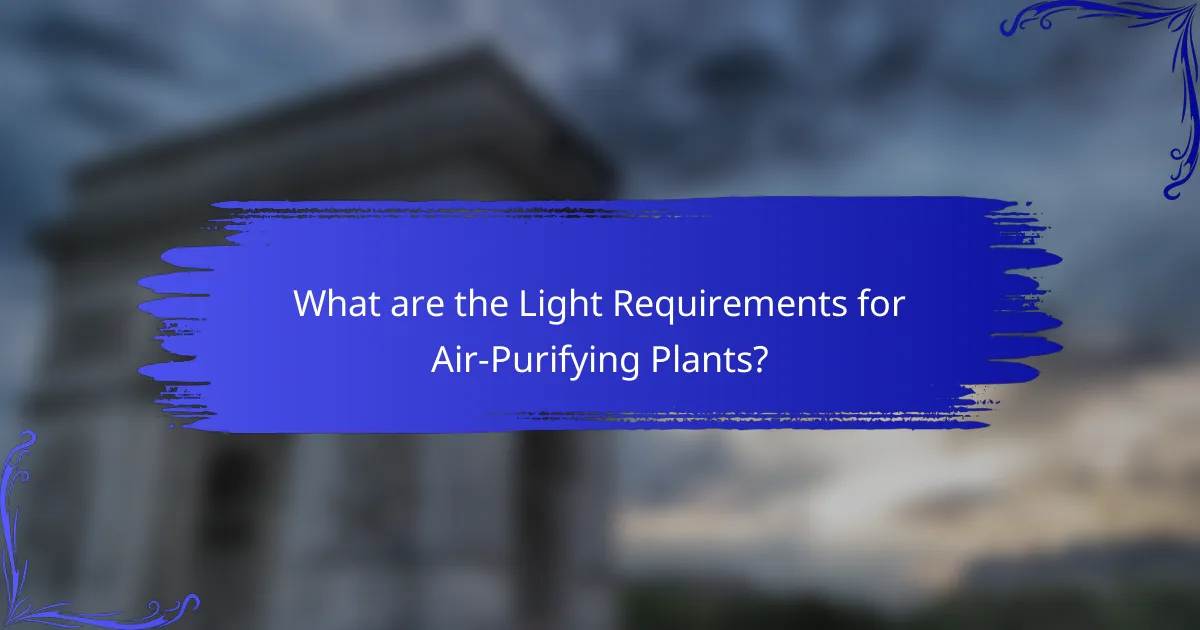Air-purifying plants, such as Snake Plants, Spider Plants, Peace Lilies, and Pothos, are essential for enhancing indoor air quality and aesthetic appeal in landscape interior design. These plants effectively filter harmful toxins like formaldehyde, benzene, ammonia, and carbon monoxide, contributing to better respiratory health and overall well-being. Each species has specific light requirements, with many thriving in bright, indirect sunlight while some can tolerate low light conditions. Proper care techniques, including adequate watering, humidity maintenance, and regular fertilization, are crucial for maximizing their air-purifying capabilities. This article outlines the best air-purifying plants, their health benefits, light needs, and essential care practices.

What are the Best Air-Purifying Plants for Landscape Interior Design?
The best air-purifying plants for landscape interior design include the Snake Plant, Spider Plant, Peace Lily, and Pothos. Snake Plants are known for their ability to filter formaldehyde and benzene. They thrive in low light and require minimal care. Spider Plants effectively remove pollutants like carbon monoxide and xylene. They adapt well to various light conditions. Peace Lilies are excellent at removing ammonia and mold spores. They prefer indirect sunlight and need regular watering. Pothos plants are versatile and can eliminate indoor toxins like formaldehyde and toluene. They can grow in low light and are easy to maintain. These plants contribute to healthier indoor air quality while enhancing aesthetic appeal.
Why are Air-Purifying Plants Important for Indoor Environments?
Air-purifying plants are important for indoor environments because they improve air quality. They absorb harmful pollutants like formaldehyde, benzene, and carbon monoxide. NASA’s Clean Air Study found that certain plants can remove up to 87% of indoor air toxins in 24 hours. This leads to healthier living spaces and can reduce the risk of respiratory issues. Additionally, these plants increase humidity levels, which can alleviate dry skin and respiratory discomfort. Incorporating air-purifying plants enhances overall well-being and creates a more pleasant atmosphere indoors.
How do Air-Purifying Plants improve indoor air quality?
Air-purifying plants improve indoor air quality by removing toxins from the air. They absorb harmful substances like formaldehyde, benzene, and trichloroethylene through their leaves and roots. This process is known as phytoremediation. Studies show that certain plants can reduce indoor air pollutants by up to 87% within 24 hours. For instance, the NASA Clean Air Study identified plants like the peace lily and spider plant as effective air purifiers. These plants not only filter air but also increase humidity, which can further enhance air quality. Overall, incorporating air-purifying plants into indoor spaces promotes a healthier environment.
What scientific studies support the benefits of Air-Purifying Plants?
Scientific studies support the benefits of air-purifying plants by demonstrating their ability to improve indoor air quality. A notable study by NASA in 1989 found that certain plants can remove toxins such as benzene, formaldehyde, and trichloroethylene from the air. This research indicated that plants like the Peace Lily and Spider Plant significantly reduced these pollutants in controlled environments. Another study published in the Journal of Physiological Anthropology in 2015 showed that indoor plants can enhance mood and cognitive function, further supporting their benefits in indoor spaces. Additionally, a review in the Environmental Science and Technology journal confirmed that plants contribute to reducing airborne volatile organic compounds (VOCs). These findings collectively highlight the positive impact of air-purifying plants on both air quality and overall well-being.
Which Plants are Considered the Best for Air Purification?
Spider plant, peace lily, and snake plant are considered the best for air purification. Spider plants remove formaldehyde and xylene from the air. Peace lilies are effective against ammonia and benzene. Snake plants can filter out formaldehyde and nitrogen oxides. According to NASA’s Clean Air Study, these plants significantly improve indoor air quality. They are easy to care for and thrive in various lighting conditions. Their ability to absorb toxins makes them ideal for homes and offices.
What are the top air-purifying plants recommended for interior design?
The top air-purifying plants recommended for interior design include the Snake Plant, Spider Plant, Peace Lily, and Pothos. Snake Plants are known for their ability to filter formaldehyde and benzene. Spider Plants effectively remove pollutants like xylene and toluene. Peace Lilies not only purify air but also add aesthetic value with their beautiful flowers. Pothos is a hardy plant that thrives in low light and removes indoor toxins. These plants are supported by research from NASA’s Clean Air Study, which identifies their effectiveness in improving indoor air quality.
How do different plants vary in their air-purifying capabilities?
Different plants vary in their air-purifying capabilities based on their specific absorption rates of toxins. For example, the snake plant absorbs formaldehyde, benzene, and xylene effectively. In contrast, the peace lily excels at removing ammonia and is also efficient against mold spores. The spider plant is known for its ability to filter out carbon monoxide and other harmful substances. Research by NASA in the Clean Air Study identifies over 50 plants that can remove indoor pollutants. Each plant’s efficiency is influenced by factors like leaf surface area, growth rate, and overall health. Thus, selecting the right plant can enhance indoor air quality significantly.
How can Landscape Interior Design Incorporate Air-Purifying Plants?
Landscape interior design can incorporate air-purifying plants by strategically placing them in various indoor spaces. These plants can be used as focal points in living areas or grouped for a lush effect. Selecting species like snake plants or peace lilies enhances air quality while adding aesthetic value. Utilizing vertical gardens or wall planters maximizes space and integrates greenery seamlessly. Additionally, incorporating plants into furniture, such as planters within tables, creates unique design elements. Ensuring adequate light and moisture is crucial for plant health. Research indicates that plants like spider plants can remove up to 90% of indoor pollutants, making them effective choices for improving air quality.
What design principles should be followed when using these plants?
When using air-purifying plants in landscape interior design, follow principles of balance, scale, and harmony. Balance involves distributing plants evenly to create visual stability. Scale ensures that plant sizes are appropriate for the space, avoiding overcrowding. Harmony is achieved by selecting plants with complementary colors and textures.
Additionally, consider the light requirements of each plant. Placing plants in suitable lighting conditions enhances their growth and air-purifying abilities. Grouping plants with similar care needs simplifies maintenance.
Using these design principles creates an aesthetically pleasing environment while maximizing the health benefits of air-purifying plants.
How can the placement of plants affect their air-purifying effectiveness?
The placement of plants significantly impacts their air-purifying effectiveness. Strategic positioning enhances airflow around the plants. Increased airflow allows for better absorption of pollutants. For instance, placing plants near windows maximizes light exposure. This encourages growth and increases their capacity to purify air. Furthermore, grouping multiple plants together can create a more effective air-cleaning zone. Research indicates that certain arrangements can improve the overall indoor air quality by up to 60%. Thus, thoughtful placement is crucial for optimizing the air-purifying benefits of plants.

What Health Benefits do Air-Purifying Plants Provide?
Air-purifying plants provide several health benefits. They improve indoor air quality by removing toxins such as formaldehyde and benzene. Studies show that plants like peace lilies and spider plants can reduce airborne pollutants. NASA’s Clean Air Study found that certain plants can filter out harmful chemicals effectively. Additionally, these plants enhance humidity levels, which can alleviate respiratory issues. Increased humidity also helps with skin hydration. Moreover, air-purifying plants can reduce stress and boost mood, contributing to overall well-being. Having greenery indoors can promote a sense of calm and improve focus.
How do Air-Purifying Plants contribute to overall wellness?
Air-purifying plants contribute to overall wellness by improving indoor air quality. They absorb harmful pollutants such as formaldehyde, benzene, and carbon monoxide. Studies show that plants can reduce airborne toxins by up to 87% in 24 hours. Increased oxygen levels from photosynthesis enhance mood and cognitive function. Additionally, these plants can increase humidity, which helps alleviate respiratory issues. The presence of greenery also reduces stress and promotes relaxation. A study published in the Journal of Physiological Anthropology found that interacting with indoor plants can lower blood pressure and improve mental health. Overall, air-purifying plants create a healthier living environment that supports physical and mental well-being.
What specific health benefits are associated with having these plants indoors?
Indoor plants provide several specific health benefits. They improve indoor air quality by filtering toxins such as formaldehyde and benzene. Studies show that plants can reduce airborne pollutants by up to 87% within 24 hours. Additionally, they increase humidity, which can alleviate respiratory issues and dry skin. Plants also enhance mood and reduce stress levels. Research indicates that interaction with indoor plants can lower blood pressure and promote relaxation. Furthermore, having plants indoors can improve concentration and productivity. A study found that employees in green office environments reported 15% higher levels of well-being.
How do these plants impact mental well-being and productivity?
Air-purifying plants positively impact mental well-being and productivity. They improve air quality by removing toxins and increasing oxygen levels. Enhanced air quality leads to better concentration and reduced fatigue. Studies show that indoor plants can lower stress levels. For instance, a study by the University of Exeter found that productivity can increase by 15% in environments with plants. Additionally, plants can promote feelings of calm and improve mood. This psychological benefit further aids in enhancing focus and creativity. Thus, incorporating air-purifying plants into interior spaces can significantly boost mental health and work efficiency.
What are the Common Misconceptions about Air-Purifying Plants?
Common misconceptions about air-purifying plants include the belief that they can completely eliminate indoor air pollution. While these plants can improve air quality, they do not remove all harmful substances. Another misconception is that all air-purifying plants are equally effective. In reality, their effectiveness varies by species. Some people think that having just a few plants is sufficient for significant air purification. Research indicates that a larger number of plants is necessary for noticeable effects. Additionally, it is often assumed that air-purifying plants require little to no care. Most species need proper light, water, and maintenance to thrive. Lastly, many believe that all indoor plants purify air. However, not all plants have the same air-cleaning capabilities.
Why do some people doubt the effectiveness of Air-Purifying Plants?
Some people doubt the effectiveness of air-purifying plants due to limited scientific evidence. Studies, such as the NASA Clean Air Study, show that certain plants can remove specific toxins. However, these studies often use controlled environments that differ from typical indoor settings. Critics argue that the actual air purification in homes is minimal. They cite the slow rate of air exchange and the small leaf surface area of many plants. Additionally, some believe that reliance on plants may overshadow other effective air purification methods. This skepticism is often fueled by misconceptions about how much air quality can improve through plants alone.
What evidence counters these misconceptions?
Research shows that many misconceptions about air-purifying plants are unfounded. For instance, a common belief is that these plants significantly improve indoor air quality. However, a study by Wolverton et al. (1989) found that while plants can absorb certain pollutants, the effect on overall air quality in typical indoor environments is minimal.
Another misconception is that all houseplants are effective air purifiers. In reality, only specific species, such as the Snake Plant and Spider Plant, have demonstrated notable air-purifying capabilities. According to NASA’s Clean Air Study, not all plants filter toxins effectively.
Additionally, some believe that having more plants will exponentially improve air quality. However, research indicates that the number of plants needed for a measurable difference is impractically high for most indoor spaces. A study published in the Journal of Exposure Science & Environmental Epidemiology (2015) supports this by showing that the air-cleaning benefits of plants diminish with increased density.
These findings highlight the importance of understanding the limitations of air-purifying plants in landscape design and their actual impact on health and air quality.

What are the Light Requirements for Air-Purifying Plants?
Air-purifying plants generally require bright, indirect light to thrive. Many species, such as the Peace Lily and Spider Plant, prefer moderate light conditions. Some can tolerate low light, but their air-purifying capabilities may diminish. For optimal growth, placing these plants near windows with filtered sunlight is ideal. Direct sunlight can harm certain varieties, causing leaf burn. Research indicates that light intensity affects photosynthesis and overall plant health. Proper light conditions enhance their ability to remove toxins from the air effectively.
How does light affect the growth of Air-Purifying Plants?
Light significantly affects the growth of air-purifying plants. It influences photosynthesis, which is essential for plant health. Adequate light promotes robust growth and enhances the plant’s ability to purify air. Insufficient light can lead to stunted growth and reduced air-purifying capabilities. Different air-purifying plants have varying light requirements. For instance, snake plants thrive in low light, while peace lilies prefer bright, indirect light. Studies show that optimal light conditions can increase the rate of photosynthesis by up to 50%. Proper lighting ensures that these plants remain healthy and effective in improving indoor air quality.
What types of light are best for different air-purifying species?
Different air-purifying species require varying types of light for optimal growth. Low-light plants, such as Snake Plant and Pothos, thrive in indirect light. Medium-light plants, like Peace Lily and Spider Plant, prefer bright, indirect light. High-light plants, such as Rubber Plant and Dracaena, benefit from direct sunlight. Research indicates that light intensity affects photosynthesis rates in plants. Studies show that adequate light promotes healthier foliage and better air purification capabilities. Specific light conditions enhance growth and efficiency in air purification for each species.
How can insufficient light impact the health of these plants?
Insufficient light can severely impact the health of air-purifying plants. These plants require adequate light for photosynthesis. Without enough light, they cannot produce the energy needed for growth. This can lead to stunted growth and poor foliage development. Additionally, insufficient light can cause leaves to yellow and drop. It may also increase susceptibility to pests and diseases. Research indicates that low light levels can reduce the overall vitality of these plants. For example, studies show that plants like the Snake Plant and Pothos thrive best in bright, indirect light. Insufficient light ultimately compromises their air-purifying abilities.
What are the Best Practices for Positioning Air-Purifying Plants?
Position air-purifying plants in locations with adequate light and airflow. Ensure they receive the appropriate amount of sunlight based on their specific needs. Avoid placing them in dark corners or areas with stagnant air. Group plants together to enhance humidity and create a microclimate. Use decorative pots that complement the interior design while allowing for drainage. Regularly rotate plants to promote even growth. Maintain a consistent watering schedule to keep plants healthy. Regularly dust leaves to maximize their air-purifying capabilities. These practices enhance the overall effectiveness of air-purifying plants in improving indoor air quality.
How can you determine the best spots for these plants in your home?
To determine the best spots for air-purifying plants in your home, assess the light conditions in each room. Most air-purifying plants thrive in bright, indirect light. Use a light meter or observe sunlight patterns throughout the day. Identify areas that receive consistent light without direct sunlight exposure.
Next, consider temperature and humidity levels. Most plants prefer temperatures between 65°F to 75°F and humidity levels around 40% to 60%. Avoid placing plants near drafts or heating vents.
Evaluate the space available for plant growth. Ensure that there is enough room for the plants to expand without obstruction. Finally, consider aesthetics and accessibility. Place plants where they can enhance the visual appeal of your space while being easy to care for.
What tools can help assess light levels for indoor plants?
Light meters are essential tools for assessing light levels for indoor plants. These devices measure the intensity of light in foot-candles or lux. A light meter can provide accurate readings to determine if a plant is receiving adequate light. Additionally, smartphone apps can estimate light levels using the device’s camera. Some apps provide a simple interface for measuring light intensity. Another useful tool is a photometer, which measures light intensity in specific wavelengths. These measurements help in selecting appropriate plants for indoor spaces. Understanding light levels is crucial for plant health and growth. Proper light assessment ensures optimal conditions for air-purifying plants.

What Care Techniques are Essential for Air-Purifying Plants?
Air-purifying plants require specific care techniques to thrive. Adequate light is essential; most air-purifying plants prefer indirect sunlight. Regular watering is necessary, but overwatering can lead to root rot. Maintaining humidity levels is also important, especially for tropical varieties. Fertilizing during the growing season supports healthy growth. Pruning dead leaves promotes better air circulation and plant health. Lastly, repotting every couple of years refreshes soil nutrients and prevents root binding. These techniques ensure optimal growth and air-purifying capabilities of the plants.
How often should Air-Purifying Plants be watered?
Air-purifying plants should generally be watered every 1 to 2 weeks. The frequency can vary based on the specific plant species and environmental conditions. Factors such as light, humidity, and temperature impact watering needs. For instance, plants in brighter light may require more frequent watering. Additionally, soil moisture levels should be checked before watering. Overwatering can lead to root rot, while underwatering can cause stress. It’s essential to adjust the watering schedule according to the plant’s response to its environment.
What signs indicate that a plant needs more or less water?
Signs that a plant needs more water include wilting leaves, dry soil, and leaf drop. Conversely, signs that a plant needs less water include yellowing leaves, root rot, and mold on the soil surface. Wilting occurs when plants lose turgor pressure due to insufficient moisture. Dry soil indicates a lack of water available for absorption. Leaf drop often happens as a stress response to drought conditions. Yellowing leaves can signify overwatering, as excess moisture affects nutrient uptake. Root rot develops when roots sit in waterlogged soil, leading to decay. Mold growth on the soil surface indicates excessive moisture and poor drainage. Recognizing these signs helps maintain optimal plant health.
How does humidity affect the care of these plants?
Humidity significantly influences the care of air-purifying plants. Higher humidity levels can enhance plant growth and reduce water stress. Many air-purifying plants, such as ferns and peace lilies, thrive in humid environments. In contrast, low humidity can lead to issues like leaf browning and increased susceptibility to pests. Maintaining humidity levels between 40% to 60% is ideal for most indoor plants. Using a humidity gauge can help monitor the environment. Regular misting or using a humidifier can also improve humidity levels. These practices support overall plant health and vitality.
What Fertilization Techniques are Effective for Air-Purifying Plants?
Organic fertilizers, such as compost and worm castings, are effective for air-purifying plants. These fertilizers provide essential nutrients while improving soil structure. They enhance microbial activity, which benefits plant health. Liquid fertilizers, like fish emulsion, also promote growth in air-purifying plants. They deliver nutrients quickly and can be applied during the growing season. Slow-release fertilizers are another option. They supply nutrients over time, reducing the need for frequent applications. Regularly testing soil pH ensures optimal nutrient availability. Following these techniques supports the overall health and air-purifying capabilities of the plants.
When and how should you fertilize these plants for optimal growth?
Fertilize air-purifying plants during the growing season, typically spring and summer. Use a balanced, water-soluble fertilizer every four to six weeks. Apply the fertilizer when the soil is moist to prevent root burn. Follow the manufacturer’s instructions for dilution rates. Observe the plants for signs of nutrient deficiency, such as yellowing leaves. Adjust fertilization frequency based on the plant’s growth and health. Regular fertilization supports optimal growth and enhances air-purifying abilities. Research indicates that well-fertilized plants can improve indoor air quality more effectively.
What types of fertilizers are most beneficial for air-purifying species?
Organic fertilizers are most beneficial for air-purifying species. They improve soil health and enhance nutrient availability. Organic options include compost, worm castings, and fish emulsion. These fertilizers release nutrients slowly, preventing nutrient burn. They also promote beneficial microorganisms in the soil. Research shows that organic fertilizers support plant growth and improve air quality. Studies indicate that well-nourished plants can absorb more toxins. This makes them more effective at purifying indoor air.
What are Common Challenges in Caring for Air-Purifying Plants?
Common challenges in caring for air-purifying plants include inadequate light, overwatering, and pest infestations. Many air-purifying plants require specific light conditions to thrive. Insufficient light can lead to stunted growth or leaf drop. Overwatering is a frequent issue, as it can cause root rot. Root rot is detrimental and can quickly kill the plant. Pest infestations, such as spider mites or aphids, can weaken the plant. Regular monitoring and proper care techniques are essential for maintaining plant health. Understanding each plant’s specific needs helps mitigate these challenges.
How can pests affect the health of these plants?
Pests can significantly harm the health of air-purifying plants. They can cause physical damage by feeding on plant tissues. This feeding can lead to wilting, stunted growth, and even plant death. Pests may also introduce diseases that can spread rapidly. Diseases can result in discoloration, leaf drop, and overall decline in plant vitality. For instance, aphids can transmit viruses that negatively impact plant health. Additionally, pests can weaken plants, making them more susceptible to environmental stressors. Effective pest management is crucial to maintaining the health of these plants.
What are the best strategies for troubleshooting plant health issues?
The best strategies for troubleshooting plant health issues include identifying symptoms, checking environmental conditions, and assessing care practices. First, recognize visible signs such as yellowing leaves, wilting, or stunted growth. These symptoms indicate potential problems like nutrient deficiencies or pests. Next, evaluate environmental factors including light, humidity, and temperature. Plants may suffer if conditions deviate from their preferred ranges. Lastly, review watering and fertilization routines. Overwatering can lead to root rot, while under-fertilization may cause nutrient deficiencies. Implementing these strategies allows for effective diagnosis and remedy of plant health issues.
What Practical Tips Can Help You Maintain Air-Purifying Plants?
To maintain air-purifying plants, ensure they receive adequate light based on their specific needs. Different plants require varying light levels; for instance, snake plants thrive in low light while pothos prefer bright, indirect light. Water the plants appropriately, allowing the soil to dry out between waterings. Overwatering can lead to root rot, which is detrimental to plant health. Regularly dust the leaves to enhance photosynthesis and air purification. Use a balanced fertilizer during the growing season to provide essential nutrients. Monitor for pests and treat infestations promptly to prevent damage. Repot plants every couple of years to refresh the soil and promote growth. Lastly, maintain optimal humidity levels, as many air-purifying plants prefer a humid environment.
How can you create a care schedule for your plants?
To create a care schedule for your plants, start by identifying each plant’s specific needs. Determine the watering frequency based on the plant species and its environment. For example, some plants require weekly watering while others may need bi-weekly. Next, establish a light requirement schedule. Note if the plant thrives in low, medium, or bright light.
Include fertilization intervals in your schedule. Many indoor plants benefit from monthly fertilization during the growing season. Additionally, plan for pruning and repotting. Pruning can be done seasonally, while repotting is typically needed every couple of years.
Use a calendar or app to track these tasks. Set reminders for watering, fertilizing, and other care activities. This structured approach helps ensure that each plant receives the appropriate care consistently.
What resources are available for learning more about plant care?
Books on plant care are widely available and offer in-depth knowledge. Titles like “The House Plant Expert” by Dr. D.G. Hessayon provide comprehensive guidance. Online platforms such as gardening websites and forums are also valuable resources. Websites like the Royal Horticultural Society offer expert advice and tips. YouTube channels dedicated to gardening feature visual tutorials on plant care. Local garden centers often hold workshops and classes. Mobile apps like PlantSnap help identify plants and provide care information. Community groups and social media platforms foster discussions and shared experiences among plant enthusiasts.
The primary entity of this article is air-purifying plants, specifically their role in landscape interior design. The article provides an overview of the best air-purifying plants, including the Snake Plant, Spider Plant, Peace Lily, and Pothos, highlighting their health benefits, light requirements, and care techniques. It discusses how these plants improve indoor air quality by removing toxins, the scientific studies supporting their effectiveness, and practical tips for their maintenance and optimal placement. Additionally, it addresses common misconceptions and challenges in caring for these plants, making it a comprehensive guide for enhancing indoor environments.
